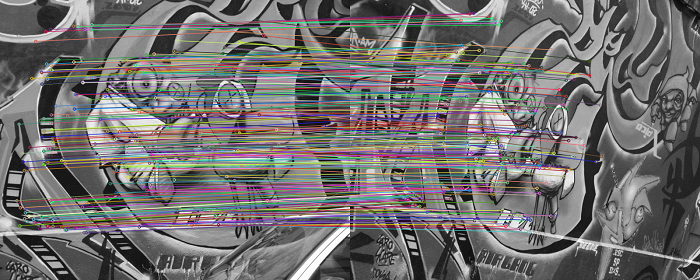
AKAZE本地功能匹配
介绍
在本教程中,我们将学习如何使用AKAZE [5]本地功能来检测和匹配两个图像上的关键点。我们将在给定的单对应矩阵的一对图像上找到关键点,匹配它们并计数
内联数(即适合给定单应性匹配的)。
您可以在此找到此示例的扩展版本:https://github.com/pablofdezalc/test_kaze_akaze_opencv
数据
我们将使用牛津数据集的Graffity序列中的图像1和3 。

Homography由3乘3矩阵给出:
7.6285898e-01 -2.9922929e-01 2.2567123e + 02
3.3443473e-01 1.0143901e + 00 -7.6999973e + 01
3.4663091e-04 -1.4364524e-05 1.0000000e + 00您可以在opencv / samples / cpp中找到图像(graf1.png,graf3.png)和单色(H1to3p.xml)。
源代码
#include <opencv2/features2d.hpp>
#include <opencv2/imgcodecs.hpp>
#include <opencv2/opencv.hpp>
#include <vector>
#include <iostream>
using namespace std;
using namespace cv;
const float inlier_threshold = 2.5f; // Distance threshold to identify inliers
const float nn_match_ratio = 0.8f; // Nearest neighbor matching ratio
int main(void)
{
Mat img1 = imread("../data/graf1.png", IMREAD_GRAYSCALE);
Mat img2 = imread("../data/graf3.png", IMREAD_GRAYSCALE);
Mat homography;
FileStorage fs("../data/H1to3p.xml", FileStorage::READ);
fs.getFirstTopLevelNode() >> homography;
vector<KeyPoint> kpts1, kpts2;
Mat desc1, desc2;
Ptr<AKAZE> akaze = AKAZE::create();
akaze->detectAndCompute(img1, noArray(), kpts1, desc1);
akaze->detectAndCompute(img2, noArray(), kpts2, desc2);
BFMatcher matcher(NORM_HAMMING);
vector< vector<DMatch> > nn_matches;
matcher.knnMatch(desc1, desc2, nn_matches, 2);
vector<KeyPoint> matched1, matched2, inliers1, inliers2;
vector<DMatch> good_matches;
for(size_t i = 0; i < nn_matches.size(); i++) {
DMatch first = nn_matches[i][0];
float dist1 = nn_matches[i][0].distance;
float dist2 = nn_matches[i][1].distance;
if(dist1 < nn_match_ratio * dist2) {
matched1.push_back(kpts1[first.queryIdx]);
matched2.push_back(kpts2[first.trainIdx]);
}
}
for(unsigned i = 0; i < matched1.size(); i++) {
Mat col = Mat::ones(3, 1, CV_64F);
col.at<double>(0) = matched1[i].pt.x;
col.at<double>(1) = matched1[i].pt.y;
col = homography * col;
col /= col.at<double>(2);
double dist = sqrt( pow(col.at<double>(0) - matched2[i].pt.x, 2) +
pow(col.at<double>(1) - matched2[i].pt.y, 2));
if(dist < inlier_threshold) {
int new_i = static_cast<int>(inliers1.size());
inliers1.push_back(matched1[i]);
inliers2.push_back(matched2[i]);
good_matches.push_back(DMatch(new_i, new_i, 0));
}
}
Mat res;
drawMatches(img1, inliers1, img2, inliers2, good_matches, res);
imwrite("akaze_result.png", res);
double inlier_ratio = inliers1.size() * 1.0 / matched1.size();
cout << "A-KAZE Matching Results" << endl;
cout << "*******************************" << endl;
cout << "# Keypoints 1: \t" << kpts1.size() << endl;
cout << "# Keypoints 2: \t" << kpts2.size() << endl;
cout << "# Matches: \t" << matched1.size() << endl;
cout << "# Inliers: \t" << inliers1.size() << endl;
cout << "# Inliers Ratio: \t" << inlier_ratio << endl;
cout << endl;
imshow("result", res);
waitKey();
return 0;
}说明
- 加载图像和单应性
Mat img1 = imread("graf1.png", IMREAD_GRAYSCALE);
Mat img2 = imread("graf3.png", IMREAD_GRAYSCALE);
Mat homography;
FileStorage fs("H1to3p.xml", FileStorage::READ);
fs.getFirstTopLevelNode() >> homography;我们正在加载灰度图像。Homography存储在使用FileStorage创建的xml中。
- 使用AKAZE检测关键点并计算描述符
vector<KeyPoint> kpts1, kpts2;
Mat desc1, desc2;
AKAZE akaze;
akaze(img1, noArray(), kpts1, desc1);
akaze(img2, noArray(), kpts2, desc2);我们创建AKAZE对象并使用它的operator()功能。由于我们不需要mask参数,所以使用noArray()。
- 使用强力匹配器找到2-nn个匹配项
BFMatcher matcher(NORM_HAMMING);
vector< vector<DMatch> > nn_matches;
matcher.knnMatch(desc1, desc2, nn_matches, 2);我们使用汉明距离,因为AKAZE默认使用二进制描述符。
- 使用2-nn匹配来找到正确的关键点匹配
for(size_t i = 0; i < nn_matches.size(); i++) {
DMatch first = nn_matches[i][0];
float dist1 = nn_matches[i][0].distance;
float dist2 = nn_matches[i][1].distance;
if(dist1 < nn_match_ratio * dist2) {
matched1.push_back(kpts1[first.queryIdx]);
matched2.push_back(kpts2[first.trainIdx]);
}
}如果最接近的比例比第二个最接近的比例更接近,则匹配是正确的。
- 检查我们的匹配是否适合单性模型
for(int i = 0; i < matched1.size(); i++) {
Mat col = Mat::ones(3, 1, CV_64F);
col.at<double>(0) = matched1[i].pt.x;
col.at<double>(1) = matched1[i].pt.y;
col = homography * col;
col /= col.at<double>(2);
float dist = sqrt( pow(col.at<double>(0) - matched2[i].pt.x, 2) +
pow(col.at<double>(1) - matched2[i].pt.y, 2));
if(dist < inlier_threshold) {
int new_i = inliers1.size();
inliers1.push_back(matched1[i]);
inliers2.push_back(matched2[i]);
good_matches.push_back(DMatch(new_i, new_i, 0));
}
}
如果从第一关键点的投影到第二关键点的距离小于阈值,则它适合于单应性。
我们为内部值创建一组新的匹配,因为它是绘制函数所必需的。
- 输出结果
Mat res;
drawMatches(img1, inliers1, img2, inliers2, good_matches, res);
imwrite("res.png", res);
...这里我们保存生成的图像并打印一些统计信息。
结果
找到匹配

A-KAZE匹配结果
Keypoints 1: 2943
Keypoints 2: 3511
Matches: 447
Inliers: 308
Inlier Ratio: 0.689038}